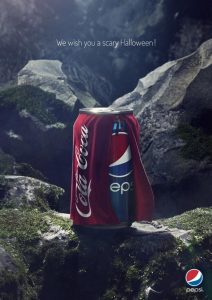by fmadmin | Oct 27, 2020 | Content
There’s only one thing better than ogling at big brand marketing campaigns – ogling at THEMED big brand marketing campaigns! In the spirit of spooky season, we’ve rounded up some of our favourite Halloween themed campaigns.
KFC Australia – Cursed Colonel
In 2019, KFC Australia partnered with Menulog to add an additional menu item – ‘trick or treat’. Selecting this menu item meant that your order would be delivered by a Cursed Colonel; a driver dressed as a zombie version of the KFC icon.
Koala Mattress – A Ghoulish ‘Easter egg’
Everyone loves an Easter egg; that hidden piece of content or quirk that people have to really pay attention to notice. Koala used this concept and gave it a spooky spin by hiding a series of Easter eggs on their site in the form of some spooky photoshopping. Customers were tasked with identifying the correct number of spooky Easter eggs that had been added to the Koala website in order to win a prize.

Burger King – the ghost of McDonald’s
We have recently had the pleasure of watching the age-old Hungry Jack’s vs McDonalds battle play out on Australian shores with the introduction of the ‘Big Jack’ burger. This long-standing feud is always accompanied by some cheeky advertising tactics and it is a delight to watch it play out.
In 2016, a Burger King in Queens, New York dressed itself up as the ghost of McDonald’s with a sign on the billboard reading “Boooo! Just kidding, we still flame grill our burgers. Happy Halloween”. The home-made costume look even plays into Burger King/Hungry Jack’s default move of the underdog.


Chobani
Less cheeky and far more wholesome, Chobani ran a campaign with adorable pups dressed in Halloween costumes enjoying their yoghurt ‘treat’. Check out the not at all spooky video here!
Pepsi – risqué costumes
In similar form to Burger King, Pepsi ran a campaign in 2013 where they dressed up a Pepsi can in a Coca Cola ‘costume’ to “scare” viewers. Cheeky but effective!

by fmadmin | Oct 27, 2020 | Content
Owning a small business is pretty scary stuff, even prior to the woes of 2020. This Halloween, we investigate the frightening risks small to medium businesses have been facing over the years and how to get your haunted house in order for 2021.
1. Not accounting for grave times
According to the Australian Bureau of Statistics, half of all SMEs go bust in the first three years of operation, why? Well according to the Australian Securities and Investment Commission, poor cash flow is the cause of 40% of SME business failures. A rule of thumb indicates that a business should have liquid assets (i.e. cash in bank accounts and very liquid investments) equal to three to six months of their operating costs. While once this might have sounded excessive, it makes startling sense now!
Unprecedented global pandemic shutdowns aside, having a ready amount of cash on hand will help see you through slow trading times during the year.
2. Being unable to pay the ferryman
So, with cash flow the main issue effecting SMEs across Australia, it comes as no surprise that businesses aren’t being paid. In fact, according to The Invoice Market, there is $76 billion worth of outstanding invoices and two million businesses struggling with unpaid bills – pretty scary stuff. The Invoice Market’s SME Cash Flow Crisis Report shows that Australian businesses are constantly owed on average $38,000 each, with excuses ranging from ‘insufficient funds’ to ‘being reviewed internally’. Sadly, it’s a vicious cycle with 85% of debtors to Australian SMEs actually being other SMEs.
Worryingly, more than a third of Australian businesses have to cash in their own personal savings to deal with their business cash flow, impacting their ability to pay for essential living expenses such as rent and food.
3. Giving away all your candy
While a smaller issue compared to cash flow and mounting bills, but a common one none the less, is giving away control of your business’ important online assets. COVID-19 bought this to light with the urgent need to operate online and update websites and social media profiles, only to be faced with the realisation that many businesses don’t have access to these company assets. Business owners unaware of who is hosting their website (let alone the log in details), not owning their social media profiles and so forth, causes a lot of hassle, not to mention lost opportunity and time.
Now is the time to take back ownership of your online presence once and for all – ensure the details are found, the information corrected and stored securely to avoid this added stress.
SMEs are vital to our economy, employing 70% of our entire workforce in Australia. While running a business is not always fun and candy, the effect your successful business can have on our employment and economic recovery as a nation is actually pretty darn sweet.
Sources:
https://www.abs.gov.au/
https://asic.gov.au/
https://www.i-q.net.au/wp-content/uploads/Apollo_TIM_Report_2017_final-1.pdf
by fmadmin | Oct 7, 2020 | Content
Overnight, the Australian Government delivered what has been deemed the ‘coronavirus budget’, the plan to salvage our economy from the trauma that was 2020. With a strong emphasis on job creation, it was unsurprising to see that small businesses were amongst the winners in this latest budget.
Hitting education, jobs, small business, environment, infrastructure, mental health and low and middle income tax payers, this budget resulted in the largest deficit in Australia since the end of World War II. Fear not, the $213.7 billion deficit is expected to be almost halved by 2021/22, with a deficit of $112 billion.
The new budget features up to 10 tax concessions for small and medium businesses, with some key perks highlighted below:
Businesses with a turnover of less than $5 billion (almost 99% of Australian businesses) can deduct the full cost of capital assets, provided they are purchased after 6 October and first used or installed by 30 June, 2022.
Small and medium businesses will be eligible to apply ‘full expensing’ to second-hand assets.
Businesses with less than $5 billion can offset losses incurred up to June 2022 against previous profits made in or after the 2019-19 financial year on which tax has been paid, generating a refund.
The SME Loans Guarantee Scheme has been expanded to allow eligible businesses to apply for secured loans of up to $1 million and unsecured up to $250,000 with repayments made over five years.
To aid in job creation, businesses are now exempt from paying 47% fringe benefits tax on retraining employees who have been made redundant or are due to be made redundant, to take on a new role within the business. This is supplemented by the ‘JobMaker’ wage subsidy which provides a wage credit of up to $200 for new hires aged under 35.
The budget also makes a $4.5 billion investment in NBN Co and commits $29.2 million to accelerate the rollout of the 5G network, alleviating the stress of connectivity issues.
While not everyone gets a win with the budget every time, it is a relief to see a strong focus on job creation and keeping Australia’s small and medium businesses afloat.

by fmadmin | Sep 21, 2020 | Content, Strategy
This month we gave our vocal cords a work-out as we serenaded ourselves with the world’s most famous song, “Happy Birthday”, as we rung in our 14th year. Little did we realise, we narrowly skipped a hefty royalty fee!
Unbeknownst to many, the “Happy Birthday” song is copyrighted and has been raking in over $2 million per year in royalties. The original version of the song, “Good Morning to You” was composed as a children’s song in 1893 by Patty and Mildred Hill. It is unknown who changed the lyrics, but the melody was copyrighted and subject to royalty payments each time it was played for commercial purposes. There’s been some controversy around who owns the copyright over the song’s lifetime, but it looks like it is due to expire in 2030.
While this fun piece of birthday trivia made for stimulating conversation over birthday cake, it got us thinking about the importance of owning what’s yours. Your brand’s equity is one of your most important assets, and all the elements that comprise this equity should be fiercely protected.
The drastic change that we’ve seen to commerce in response to COVID-19 has made it clear that brands have more value than ever. While businesses have struggled to stay afloat, we have seen a rise in consumer loyalty as shoppers scramble to prop up their beloved brands.
Consumers are far more conscious about where they spend their precious dollars right now, so they are thinking not only about the short term benefits of their purchase but the long term – will the brands I really love be around in six months’ time? What am I doing to make sure they are? Rather than looking for the best price, despite the economic pressure many of us are facing, consumers are willing to spend a little extra if it means keeping jobs in the community or supporting someone local.
This conscious form of consumerism where customers actively buy products from brands they feel deserve their support is known as ‘buycotting’ and unlike the word’s counterpart, it’s something you want to encourage.
As purse strings tighten and we become more aware of the fragility of small business, people are more thoughtful than ever about where their dollars are really ending up and if the recipient is worthy of their hard-earned cash. The brands who are benefiting from this buycotting culture are those who have nurtured relationships, who invoke an emotional connection with their customers and who clearly communicate who they are and what they stand for.
Owning your brand is a crucial step to achieving this deep level of loyalty from your customers. Having a strong image of what constitutes your brand and everything that it represents is what helps customers form these emotional bonds. Your brand’s equity is made up of more than just your logo and website – it’s all about how you do business. It’s the warm smile at the cash register, the handwritten note you pop in with deliveries, it’s remembering the names of your regulars and demonstrating that you share their values. It is important to tie all of these intangible assets to your tangible ones (like your logo and website) so that people can easily make the connection between their positive feelings towards your business and your actual brand when making purchasing decisions.
To achieve this, it is critical that you not only have a strong brand, but you have control over all the elements of that brand and have ownership of them, be it trademarks, social media handles (and their associated login details!) or owning associated domain names wherever possible. Take a leaf out of Patty and Mildred’s book and recognise what you’ve created, and guard it with your life!

by fmadmin | Jul 28, 2020 | Content, Digital
Is it just me or does it feel like words are disappearing from the web and our lives?
Not only are we favouring social media that’s heavy on visuals, like Instagram and Pinterest, even social media apps like Twitter – that are all about words – are limited to 280 letters.
I noticed this decline in written content, when I went to a news article site and a video started playing. Later, scrolling through various websites, I noticed in horror that some small business websites were completely devoid of written content. Instead they filled their websites with nothing but pictures, videos and icons – no welcome paragraph or what services they offer or the benefit of choosing them over their competitors – nothing. Na-da. Zilch.
Personally, I think we have forgotten the significance of writing and reading to communicate, and that not everyone prefers audio and visual. Some of us – and yes obviously being a writer and all, I am the ‘some of us’ – would prefer to read and write to communicate rather than be spoken to or bombarded with vivid images, videos and noise.
Even in our personal lives it feels like the majority of stories are now told via video, audio or Gifs? Between listening to podcasts on the way to work, scrolling through Insta in our lunch breaks and sitting down to watch Netflix in the evenings, we are missing the quiet and calming effects that reading stories can bring to our lives.
And it turns out science is on my side. Huh! According to a journal article published on the National Center for Biotechnology Information (NCBI) website, more screen-time has been linked with shorter sleep duration, decreased sleep efficiency, and longer sleep onset delay.
So, why do we now lean towards visual and audible aids compared to words on a page or online? Because it’s easier! Having a book read to you requires no arm strain due to holding said 1-kilogram book (hard cover anyone?), and relaxing in front of the telly watching a story unfold before your eyes means no work for your imagination to conjure the characters and settings found in words.
Hey, don’t get me wrong, I love the easy way too, but I do call for a reprieve from the excessive amount of audio and visuals now found online that are taking over the way we communicate to our clients and customers.
I think the last few years has seen a resurgence in simplicity, and while making bread from scratch and knitting is becoming almost trendy, I think an increase in the amount of people retreating from the visual and auditory disruptions we receive constantly throughout our day is the next trend.
Perhaps, this is the answer businesses have been looking for to cut through the online competition. By delivering your online branding and communications through the use of a unique tone of voice (that’s lovingly weaved into quality written copy), could make you stand out in the crowd.
Let’s bring back the words, for a simple and effective way to inform clients and customers of what you do best, without all that noise and eye strain.
If this article sounds like your website and you’re not sure where to start, order our personalised website review online to get expert advice on how to improve your website and online presence yourself.
by fmadmin | Jun 8, 2020 | Content, Digital, Training
As a journalist who has written for both print publications and online content, I’ve found the difference between print and web content is actually the reader.
You see a print reader is generally relaxed, sitting in a comfy chair with some spare time and less fatigued eyes. Whereas, online readers are usually attached to a work desk or utilising a small mobile device – they’re stressed, time poor and fatigued. Therefore, they don’t tend to read as much, instead they scan content and only take in ‘snack’ size pieces of information.
How to write for the online reader
Get to the point
Arrange your content with the most important information at the top, similar to how news articles and press releases are written, this is the best way to get to the point. The most important content is usually what your website page is about, for example, if it’s your home page it will have who, what, where and how your business/service/product operates.
Web copy needs to be:
- Concise – Think of it as half the word count of print publications. Keep your headings short (less than 10 words long) and discuss only one idea per paragraph. A paragraph of web copy is about 10 – 150 words long and you might have up to two paragraphs on one topic but only one idea per paragraph.
- Scannable – Use short sentences, bullet points, lists, highlight key words and underline hyperlinks.
- Credible – Your content needs to be accurate and trustworthy, so research your facts and figures. And triple check your spelling and grammar.
- Objective – Avoid obvious promotional writing or being too jargon heavy, ensure there is clear direction as to where the reader should go next to learn more, buy or contact you.
Keep it modern
How I can tell if a website is dated (aside from design) is it will read like a mission statement for the business! Your website copy is to tell the reader what’s in it for them – what solutions you can provide, what are the benefits of using your product and services and why should they choose you over your competitors.
Remember, it’s all about them. What you can do for them, how you can solve their problem. Ideally, only your ‘about us’ page should be about you and your mission statement.
TIP: Test your copy by reading content aloud and asking, ‘so what?’ Does this paragraph benefit a reader, client or customer?
Web copy is copywriting
I describe copywriting as ‘writing words that sell’. When writing to sell, try not to focus on the features, instead sell the benefits.
For example:
The features of accounting services might be – Tax planning with a qualified accountant
The benefits of accounting services could be – Freedom to concentrate on growing your business by letting us worry about your tax.
Turn your features into benefits for the reader and you’ll succeed two-fold, your content will be all about them and you’ll increase sales in your product or services. Regardless of your business or industry, or whether the purpose of your website is to persuade, sell, inform, enforce compliance or entertain, your website content should always be written with the reader in mind.





